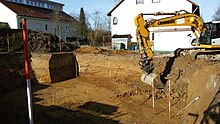Subgrade
In the building industry, the technically processed surface of a soil layer with defined properties is generally referred to as planum or planie ( Latin: planum = level, surface) . The specified properties include evenness, inclination and position in line with the profile. Such surfaces are usually produced in earthworks , road construction , track construction and in horticulture .
Definition
Earthworks
In earthworks, the subgrade (also called subgrade , subgrade or subgrade ) forms the upper end surface of the subsoil (existing subsoil ) or the substructure (artificial embankment) and at the same time, together with the soil below, provides the abutment for an overlying structure (usually road superstructure , Track superstructure or building ). The subgrade in an excavation pit is also called the excavation base . If, on the other hand, it is a matter of excavation for a traffic route, the subgrade is also referred to as the case sole .
The surface must be made level, conform to the profile and, if necessary, be slightly inclined. The deviation from the target height may only be a few centimeters. Unevenness on a defined measuring section (usually 4 meters) must also be limited to a few centimeters. If the subgrade is to serve as a foundation level for a building foundation, a horizontal surface is required. If, on the other hand, road or track construction follows the earthworks, the surface is formed with a transverse slope. The transverse slope is produced either on one side or on both sides (with a subgrade kink) and is based on the transverse slope of the road structure or the track structure. With the help of the transverse slope, seeping surface water can quickly flow to the side and permanent moisture penetration of the earthworks with the associated disruption of the load-bearing capacity is prevented. However, unevenness, which has arisen, for example, when construction vehicles drive on it, must be removed, as these hinder the surface water runoff.
Road construction
In road construction, the subgrade is usually followed by the installation of an unbound base course . Its upper end surface is also referred to as a fine subgrade or fine subgrade (in Switzerland, however, only subgrade ), as it is a surface with particular accuracy. The requirements with regard to evenness and the correct position are therefore higher than for the subgrade below. In order to ensure a constant layer thickness for the layers above, the fine subgrade is given the same transverse slope as the bound road surface.
Track construction
In track construction, a distinction is made between subgrade and subgrade. The subgrade corresponds to the subgrade in road construction and, as standard, forms the base for the so-called protective layers . These include the frost protection layer and the formation protection layer . Similar to road construction, higher demands are placed on the subgrade on the upper protective layer in terms of evenness and the correct position than on the subgrade below. In order to be able to drain away surface water from the gravel bed laterally, the subgrade is inclined on one side for single-track routes and on two sides for double-track routes.
horticulture
The finally technically processed surface of the vegetation base layer is called fine subgrade in horticulture . It may only deviate a few centimeters from the nominal height and must be free of coarse components (such as stones).
Manufacturing
A subgrade is only made by hand for very small areas. Excavators , bulldozers and graders are usually used to process larger areas . Modern equipment have a sensitive equipment hydraulics and in addition with a leveling system (with total station -, laser or GPS control) be equipped, so that the production of a fine plane is possible. The compaction is then carried out with vibrating plates , rollers or plate compactors.
Test methods
The correct position and the transverse slope of the subgrade can be checked either by means of leveling or station-related cord measurement. Depending on the density of the measuring points, these methods can also be used to roughly check the flatness. On the other hand, the flatness measurement is more precise with the help of a 4 meter long straightedge and a measuring wedge.
Norms and standards
- Germany
- Additional technical contract conditions and guidelines for earthworks in road construction (ZTV E-StB)
- Guidelines for the standardization of the superstructure of traffic areas (RStO 12)
- Ril 836 - Planning, building and maintaining earthworks and other geotechnical structures
- DIN 18915 - Vegetation technology in landscaping - Soil work
- DIN 18917 - Vegetation technology in landscaping - Lawn and sowing
- Austria
- RVS 03.08.63 superstructure measurement
- RVS 08.03.01 earthworks
- Switzerland
- SN 640 302b road and track structure; terminology
- SN 640 575 Earthworks, general
- SN 640 576 Excavation and pouring work, implementation regulations
- SN 640 585b Compaction and load-bearing capacity, requirements
- SN 640 588a Compaction, machine compaction
Web links
Individual evidence
- ↑ Norbert Peter: Lexicon of construction technology . CF Müller, 2004, ISBN 3-7880-7763-8 , page 525.
- ^ Research Society for Roads and Transport: Definitions, Part: Transport Planning, Road Design and Road Operation . FGSV Verlag, Cologne 2000.
- ↑ Bernhard Lichtberger: Manual track . Eurailpress in DVV Media Group, 2010, ISBN 3-7771-0400-0 , p. 206 .
- ^ Stephan Winninghoff: The construction site manual for gardening and landscaping . Forum Verlag Herkert GmbH, 2015, ISBN 3-86586-658-1 .
- ↑ Wilfrid Eymer: Fundamentals of earth movement . Kirschbaum Verlag, 2007, ISBN 3-7812-1664-0 .




